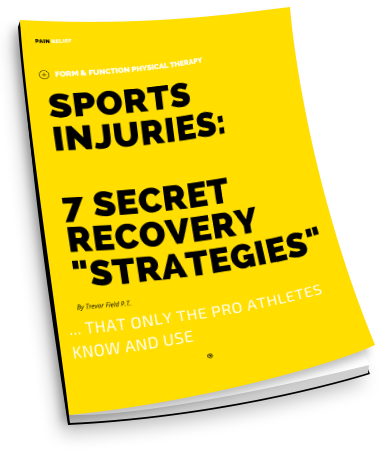Can You Run with Knee Arthritis?
One common question I get very often in the clinic is “Is it okay — or even possible — to run safely with knee arthritis?”.
It’s not uncommon for these individuals to have been told by others that running is “bad for your joints” or that “it causes arthritis”… but there’s a lot to unpack behind those claims.
To put it bluntly, running is not an inherent cause behind arthritis! And, it’s entirely possible to continue running safely with knee arthritis, as long as you know what considerations to keep in mind as you train.
So, let’s dispel these misconceptions about running wrecking your knees and review the actual science behind knee arthritis and running.
What Exactly is Arthritis?
Most everyone has heard of the term “arthritis” before, but not everyone truly knows what the diagnosis means.
In its simplest definition, arthritis indicates change in any joint of the body. It specifically refers to changes in the hyaline cartilage and underlying bone — the cartilage acts like something of a shock absorber for the joint, but it wears away over time. When the cartilage starts to degenerate, the bone underneath is exposed to loading and forces it wasn’t built to tolerate.
As a result, the body responds by trying to build more bone. Unfortunately, that tissue isn’t as dense as the original bone and ends up creating bone spurs that are subjected to the same level of loading.
This is where the joint starts to experience pain: the bony spurs create a rough texture that causes friction within the joint. As the cartilage continues to wear away, you effectively have a “bone-on-bone” reaction that causes swelling and painful symptoms.
What Causes Arthritis?
Now, we already addressed the elephant in the room: the act of running doesn’t inherently cause arthritis. But plenty of our runners still have associated concerns that running contributes to arthritis pain or worsens their diagnosis.
So, we’re here to clear the air — arthritis is effectively caused by any kind of movements that load the joint abnormally, and in excessive amounts.
There’s no one specific movement pattern that causes the problem. More so, the issue is caused by repetitive motions with improper biomechanics that cause undue stress against the joint and increases the deterioration of cartilage.
Proper form, biomechanics, and alignment are keys to preventing excess loading on the joints. With running in particular, it’s important to have a thorough understanding of your body and how it tolerates impact forces. Aspects like cadence, foot landing, and active shock absorption can have a significant effect on how much stress or strain your joints have to manage.
It’s also important to remember that your bones and cartilage are made of living tissue, just like your muscles. Your bony tissue is just as sensitive to loading and needs sufficient time to recover between bouts of physical activity. With arthritis in particular, you’re at risk of damaging the tissue if you go from little to no training to a sudden increase in training.
Why Do People Think Running Causes Arthritis?
Ultimately, running is a knee-dominant activity, so no matter how well you adapt your form, you’ll still always be loading your knees more.
This alone is not enough to cause injury or develop arthritis, but without extensive knowledge behind running biomechanics, people presume that running is the cause. Plenty of medical professionals advise runners to stop running when dealing with knee problems or pain, so it’s become a preconceived notion that running is inherently bad for your knees.
That, plus the increased loading and the potential for improper biomechanics, is the reason why runners have such a high volume of knee injuries compared to anything else. The sport is also super repetitive in nature, so the effect of increased loading and external forces can be pretty rough on the body.
But thankfully, perceptions of running are far from the biomechanical truth! Let’s review the logistics behind running and knee arthritis and how you can maintain healthy joints through your sport.
So, Can You Run with Arthritis?
Here’s the thing about arthritis: people think of it as a one size fits all diagnosis, but it can actually be diagnosed as a range of how severe it is, typically identified as grade 1 through 4.
The truth of the matter is that everyone above the age of 40 experiences some degree of arthritic changes to their knees. Meaning, a majority of people who run are technically running with knee arthritis — just without the symptomatic pain.
People most commonly experience minimal changes in the knee (and oftentimes, they don’t even know it’s happening). In this case, running is actually a big benefit to the longevity of their knees, as it can help increase the blood flow to the cartilage and continually remodel the bony tissue. Because the bony tissue responds well to impact, running can actually help preserve the health of your joints (as long as it’s practiced in a way that’s therapeutic to the body and not overloading it).
Arthritis becomes more of an issue when there’s another problem in the joint, like a partial meniscus removal or issues with the ACL. A combination of these diagnoses further complicate the joint’s stability and shock absorption.
This is where most people assume it’s not okay to run anymore. Once their knee starts to hurt, they speak with a medical professional who will diagnose the arthritic changes and recommend that they don’t run to avoid “worsening” the issue.
But, a diagnosis doesn’t automatically mean that you should stop running! More so, it’s about being respectful of how severe the diagnosis is and what you need to do to account for it with your training.
How to Safely Run with Arthritis
The most important rule of running with arthritis is to listen to your body!
Ultimately, if you can run at your current capacity and feel fine (or you only get low-level aches and pains that go away after your runs), you likely aren’t worsening the issue. The benefits of running will far outweigh the possible issues that could occur locally at the knee.
However, if you experience any symptoms — pain, swelling, or limited functionality at the knee — that’s when you’ll need some time off from running to reevaluate your training load. Again, this doesn’t mean that you have to stop running entirely! Exercise caution when dealing with these red flag symptoms, and speak with a specialist to adjust your training plan.
Focus on what symptoms you experience and how your body responds to training as you progress. One of the biggest risk factors for worsened arthritis is taking on too much, too fast, so be sure to really dial into the gradual progression of your training plan!
Best Practices for Safe Running
We know that this information sounds pretty broad — but in the grand scheme of things, the best practices for training with knee arthritis are quite similar to general training.
For instance, when you’re just starting out, make sure you start slow and ease into your training. Rather than focusing on how much you run and how quickly you increase your miles, dial into running technique and biomechanics. When you soundproof your form, you’re ensuring better protection for your knees and overall efficiency with your training.
And when you do try to increase your miles, don’t focus on increasing the distances in your individual miles. Focus on your weekly mileage as a whole and progress that so you aren’t pushing yourself too hard with every run.
The other best practice is to make sure you give your body more time to recuperate between workouts. For the first 2-3 weeks, only run a maximum of 2 days per week that way your tissues have plenty of time to respond to the impact forces and recover between runs.
If you can consistently run those first few weeks without any issues, you can add another day into your weekly routine! The key is all in the progression — run 3 days a week for another 2-3 weeks, keeping tabs on how your body reacts to the increased training and ensuring that you aren’t experiencing any red flag symptoms.
Happy, Safe Running!
And there you have it: the basics on how to manage running with knee arthritis.
Now, you might be thinking that it all seems a little too easy… if it was as simple as just progressing slowly and not overdoing it, medical professionals wouldn’t be so quick to tell you to stop running, right?
In a sense, that’s true. But the concern isn’t as much to do with the diagnosis of arthritis than with running itself — many runners unknowingly present deficiencies that can lead to compensation and possible detriment to the knee.
This is where in-depth gait analysis and the expertise of a physical therapist comes into play! You may still feel some hesitation about seeking help from another medical professional, and that’s totally understandable. (The last thing you want is for another person to tell you not to run.) But, now that you know running with knee arthritis is possible, and that there are safe practices you can find the right specialist who will acknowledge your motivation and prioritize your goals.
If you liked this article make sure to download your FREE report on:
7 WAYS TO IMPROVE RUNNING & DECREASE THE CHANCE OF INJURY
Or if you want to read our other blog posts, click HERE to visit the Blog Page.
Finally, if you already feel like you have enough information and you’re ready to get help from providers that take the time and attention you deserve, then click HERE to request a $35 Discovery Visit with one of our expert physical therapists.
And if you are ready to find out a little bit more about us…
Check out our latest Episode of the Stay In The Game Podcast
Powered by RedCircle
If you found this article helpful you might like:
A Physical Therapist’s Guide to Balance Problems
5 Benefits of Exercise for Aging Adults
Adapted from:
By Dr. Torey Page DPT OCS







